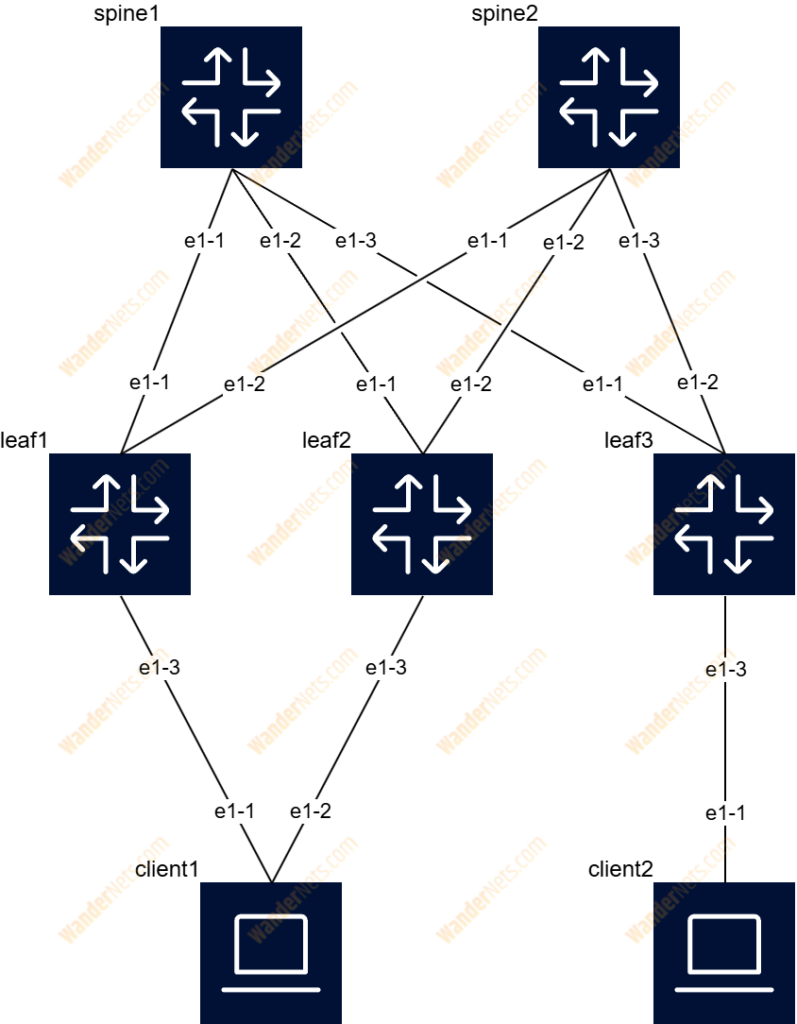The revolution in network labs is real! A few years ago, setting up and testing a network architecture required purchasing physical devices, cabling them together, and enduring the noise of spinning fans, all just to run a few commands and experiment.
Times have changed. With the growing popularity of virtual machines running network operating systems (NOSes), we can now create virtual network topologies on our laptops. However, this approach has drawbacks: large topologies demand significant resources, and the deployment process can be time-consuming.
Thankfully, there’s a modern alternative: containers. In this article, we’ll show how to deploy a Nokia SR-Linux-based data center with MC-LAG in seconds, using containers.
Why Containers?
Containers offer a lightweight alternative to virtual machines. While both have their pros and cons, containers are a perfect fit for our use case.
However, before we jump into the deployment, we need a way to manage these containers. The best tool for the job? Containerlab.
Containerlab
Containerlab is a powerful tool designed for network engineers. Developed by Nokia (with significant contributions from Roman Dodin), it allows for rapid deployment of container-based network topologies.
As the name suggests, Containerlab leverages container runtimes like Docker to build network topologies. In our case, we’ll use Docker to run pre-configured SR-Linux nodes, meaning the entire topology will be up and fully operational after a single command.
Before we dive into the deployment, let’s install Containerlab.
Installation
Multiple installation methods are available, all well-documented in the official guide.
Docker Image
To deploy SR-Linux nodes, we need a Docker image. Fortunately, Nokia provides it for free via the GitHub Container Registry.
Topology
Our topology consists of:
- 2 spine switches
- 3 leaf switches
- 2 clients

Even the client devices are SR-Linux containers, designed to simulate typical end-host scenarios:
- Client1: uses LACP bonding with VLAN tagging
- Client2: uses a classic L3 interface configuration
You can find a detailed breakdown of this setup in our previous article.
Let’s now explore the topology definition from the perspective of Containerlab.
Files and Repository
All topology files referenced in this article are available in this GitHub repository.
Definition
Containerlab uses a main YAML file to define the topology. Ours is called topology.yaml.clab. Let’s walk through its main sections.
name: sr-linux-mclag
topology:
kinds:
nokia_srlinux:
image: ghcr.io/nokia/srlinux
nodes:
leaf1:
kind: nokia_srlinux
startup-config: configs/leaf1.cfg
leaf2:
kind: nokia_srlinux
startup-config: configs/leaf2.cfg
leaf3:
kind: nokia_srlinux
startup-config: configs/leaf3.cfg
spine1:
kind: nokia_srlinux
type: ixrd3
startup-config: configs/spine1.cfg
spine2:
kind: nokia_srlinux
type: ixrd3
startup-config: configs/spine2.cfg
client1:
kind: nokia_srlinux
startup-config: configs/client1.cfg
client2:
kind: nokia_srlinux
startup-config: configs/client2.cfg
links:
# leaf to spine links POD1
- endpoints: ["leaf1:e1-1", "spine1:e1-1"]
- endpoints: ["leaf1:e1-2", "spine2:e1-1"]
- endpoints: ["leaf2:e1-1", "spine1:e1-2"]
- endpoints: ["leaf2:e1-2", "spine2:e1-2"]
# leaf to spine links POD2
- endpoints: ["leaf3:e1-1", "spine1:e1-3"]
- endpoints: ["leaf3:e1-2", "spine2:e1-3"]
# client connection links
- endpoints: ["client1:e1-1", "leaf1:e1-3"]
- endpoints: ["client1:e1-2", "leaf2:e1-3"]
- endpoints: ["client2:e1-1", "leaf3:e1-3"]Kinds
This section lets us define common attributes for each device type used in the topology. Since all our nodes use the nokia_srlinux kind and the same container image, we define the image once here. Containerlab will apply it to all nodes of that kind automatically.
Nodes
Here we define each container to be deployed. Each node has:
- A unique hostname as the key
- A kind, referencing the device type
- A startup-config parameter, pointing to a config file that will be applied at boot
Because the image is already defined in the kinds section, we don’t need to repeat it here.
Links
This section defines point-to-point connections between containers. Each entry describes a pair of endpoints, which makes wiring up the entire network simple.
Configs
Each node has its own configuration file. These files include the CLI commands that will be executed immediately after the container boots.
Let’s take a quick look at part of the configuration for spine1.
set / interface ethernet-1/1 admin-state enable
set / interface ethernet-1/1 mtu 9412
set / interface ethernet-1/1 ethernet port-speed 10G
set / interface ethernet-1/1 subinterface 0 admin-state enable
set / interface ethernet-1/1 subinterface 0 ip-mtu 9398
set / interface ethernet-1/1 subinterface 0 ipv4 admin-state enable
set / interface ethernet-1/1 subinterface 0 ipv4 address 192.0.2.0/31With this setup, there’s no need to configure devices manually after deployment, because Containerlab handles it all.
Deployment
To deploy the entire topology, simply run the sudo containerlab deploy command inside the topology directory.
You can also use built-in alias clab instead of containerlab.
lukrad@SiedliskoZua:~/Documents/sr-linux-mclag/topology$ sudo clab deploy
INFO[0000] Containerlab v0.60.1 started
INFO[0000] Parsing & checking topology file: topology.clab.yaml
INFO[0000] Creating docker network: Name="clab", IPv4Subnet="172.20.20.0/24", IPv6Subnet="3fff:172:20:20::/64", MTU=1500
INFO[0000] Creating lab directory: /home/lukrad/Documents/sr-linux-mclag/topology/clab-sr-linux-mclag
INFO[0000] Creating container: "client2"
INFO[0000] Creating container: "spine1"
INFO[0000] Creating container: "leaf3"
INFO[0000] Creating container: "client1"
INFO[0000] Creating container: "leaf1"
INFO[0000] Creating container: "leaf2"
INFO[0000] Running postdeploy actions for Nokia SR Linux 'client2' node
INFO[0001] Created link: client2:e1-1 <--> leaf3:e1-3
INFO[0001] Running postdeploy actions for Nokia SR Linux 'leaf3' node
INFO[0001] Running postdeploy actions for Nokia SR Linux 'leaf1' node
INFO[0001] Running postdeploy actions for Nokia SR Linux 'leaf2' node
INFO[0001] Created link: client1:e1-1 <--> leaf1:e1-3
INFO[0001] Created link: client1:e1-2 <--> leaf2:e1-3
INFO[0001] Running postdeploy actions for Nokia SR Linux 'client1' node
INFO[0001] Created link: leaf1:e1-1 <--> spine1:e1-1
INFO[0001] Created link: leaf2:e1-1 <--> spine1:e1-2
INFO[0001] Created link: leaf3:e1-1 <--> spine1:e1-3
INFO[0001] Running postdeploy actions for Nokia SR Linux 'spine1' node
INFO[0034] Creating container: "spine2"
INFO[0035] Created link: leaf1:e1-2 <--> spine2:e1-1
INFO[0035] Created link: leaf2:e1-2 <--> spine2:e1-2
INFO[0035] Created link: leaf3:e1-2 <--> spine2:e1-3
INFO[0035] Running postdeploy actions for Nokia SR Linux 'spine2' node
INFO[0055] Adding containerlab host entries to /etc/hosts file
INFO[0055] Adding ssh config for containerlab nodes
INFO[0055] 🎉 New containerlab version 0.68.0 is available! Release notes: https://containerlab.dev/rn/0.68/
Run 'containerlab version upgrade' to upgrade or go check other installation options at https://containerlab.dev/install/
╭─────────────────────────────┬───────────────────────┬─────────┬───────────────────╮
│ Name │ Kind/Image │ State │ IPv4/6 Address │
├─────────────────────────────┼───────────────────────┼─────────┼───────────────────┤
│ clab-sr-linux-mclag-client1 │ nokia_srlinux │ running │ 172.20.20.6 │
│ │ ghcr.io/nokia/srlinux │ │ 3fff:172:20:20::6 │
├─────────────────────────────┼───────────────────────┼─────────┼───────────────────┤
│ clab-sr-linux-mclag-client2 │ nokia_srlinux │ running │ 172.20.20.2 │
│ │ ghcr.io/nokia/srlinux │ │ 3fff:172:20:20::2 │
├─────────────────────────────┼───────────────────────┼─────────┼───────────────────┤
│ clab-sr-linux-mclag-leaf1 │ nokia_srlinux │ running │ 172.20.20.3 │
│ │ ghcr.io/nokia/srlinux │ │ 3fff:172:20:20::3 │
├─────────────────────────────┼───────────────────────┼─────────┼───────────────────┤
│ clab-sr-linux-mclag-leaf2 │ nokia_srlinux │ running │ 172.20.20.5 │
│ │ ghcr.io/nokia/srlinux │ │ 3fff:172:20:20::5 │
├─────────────────────────────┼───────────────────────┼─────────┼───────────────────┤
│ clab-sr-linux-mclag-leaf3 │ nokia_srlinux │ running │ 172.20.20.4 │
│ │ ghcr.io/nokia/srlinux │ │ 3fff:172:20:20::4 │
├─────────────────────────────┼───────────────────────┼─────────┼───────────────────┤
│ clab-sr-linux-mclag-spine1 │ nokia_srlinux │ running │ 172.20.20.7 │
│ │ ghcr.io/nokia/srlinux │ │ 3fff:172:20:20::7 │
├─────────────────────────────┼───────────────────────┼─────────┼───────────────────┤
│ clab-sr-linux-mclag-spine2 │ nokia_srlinux │ running │ 172.20.20.8 │
│ │ ghcr.io/nokia/srlinux │ │ 3fff:172:20:20::8 │
╰─────────────────────────────┴───────────────────────┴─────────┴───────────────────╯Once deployed, Containerlab provides a table listing all active nodes. You can log in via SSH into each one using its hostname. The default credentials for Nokia SR-Linux are:
Username: admin
Password: NokiaSrl1!lukrad@SiedliskoZua:~/Documents/sr-linux-mclag$ ssh admin@clab-sr-linux-mclag-leaf1
Warning: Permanently added 'clab-sr-linux-mclag-leaf1' (ED25519) to the list of known hosts.
................................................................
: Welcome to Nokia SR Linux! :
: Open Network OS for the NetOps era. :
: :
: This is a freely distributed official container image. :
: Use it - Share it :
: :
: Get started: https://learn.srlinux.dev :
: Container: https://go.srlinux.dev/container-image :
: Docs: https://doc.srlinux.dev/24-10 :
: Rel. notes: https://doc.srlinux.dev/rn24-10-1 :
: YANG: https://yang.srlinux.dev/v24.10.1 :
: Discord: https://go.srlinux.dev/discord :
: Contact: https://go.srlinux.dev/contact-sales :
................................................................
(admin@clab-sr-linux-mclag-leaf1) Password:
Using configuration file(s): ['/home/admin/.srlinuxrc']
Welcome to the srlinux CLI.
Type 'help' (and press <ENTER>) if you need any help using this.
--{ running }--[ ]--
A:leaf1#Since those are normal Docker containers, we can display a list of running instances with the docker ps command.
lukrad@SiedliskoZua:~/Documents/sr-linux-mclag/topology$ docker ps
CONTAINER ID IMAGE COMMAND CREATED STATUS PORTS NAMES
c56fab0adacc ghcr.io/nokia/srlinux "/tini -- fixuid -q …" About a minute ago Up About a minute clab-sr-linux-mclag-client1
5f7550d5ef26 ghcr.io/nokia/srlinux "/tini -- fixuid -q …" About a minute ago Up About a minute clab-sr-linux-mclag-leaf2
fe6315d19bc6 ghcr.io/nokia/srlinux "/tini -- fixuid -q …" About a minute ago Up About a minute clab-sr-linux-mclag-client2
da72094dd941 ghcr.io/nokia/srlinux "/tini -- fixuid -q …" About a minute ago Up About a minute clab-sr-linux-mclag-leaf3
fe1095fb3937 ghcr.io/nokia/srlinux "/tini -- fixuid -q …" About a minute ago Up About a minute clab-sr-linux-mclag-spine2
38001534b0ce ghcr.io/nokia/srlinux "/tini -- fixuid -q …" About a minute ago Up About a minute clab-sr-linux-mclag-leaf1
c87375aac24a ghcr.io/nokia/srlinux "/tini -- fixuid -q …" About a minute ago Up About a minute clab-sr-linux-mclag-spine1Cleanup
We can perform a cleanup of the deployed topology by executing one command – sudo clab destroy.
lukrad@SiedliskoZua:~/Documents/sr-linux-mclag/topology$ sudo clab destroy
INFO[0000] Parsing & checking topology file: topology.clab.yaml
INFO[0000] Parsing & checking topology file: topology.clab.yaml
INFO[0000] Destroying lab: sr-linux-mclag
INFO[0001] Removed container: clab-sr-linux-mclag-client2
INFO[0001] Removed container: clab-sr-linux-mclag-leaf3
INFO[0001] Removed container: clab-sr-linux-mclag-spine1
INFO[0001] Removed container: clab-sr-linux-mclag-leaf2
INFO[0001] Removed container: clab-sr-linux-mclag-leaf1
INFO[0001] Removed container: clab-sr-linux-mclag-client1
INFO[0001] Removed container: clab-sr-linux-mclag-spine2
INFO[0001] Removing containerlab host entries from /etc/hosts file
INFO[0001] Removing ssh config for containerlab nodes Summary
Containerlab makes network testing incredibly efficient. In just seconds, we deployed a fully configured data center topology with MC-LAG using Nokia SR-Linux containers. Learning and experimenting have never been easier.
Curious about automating tests for your deployed topology using Python? Read how to perform Automated SR-Linux Smoke Testing with Containerlab, gNMI & pytest.
Authors


One thought on “Deploy a Nokia SR-Linux MC-LAG Lab in Seconds with Containerlab”